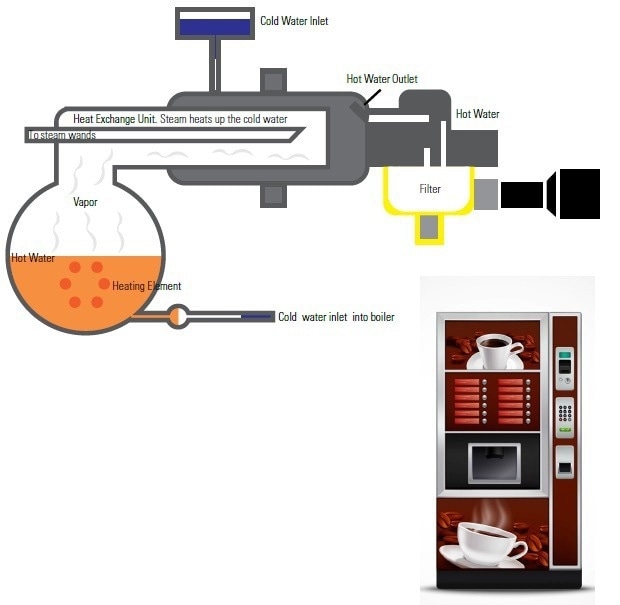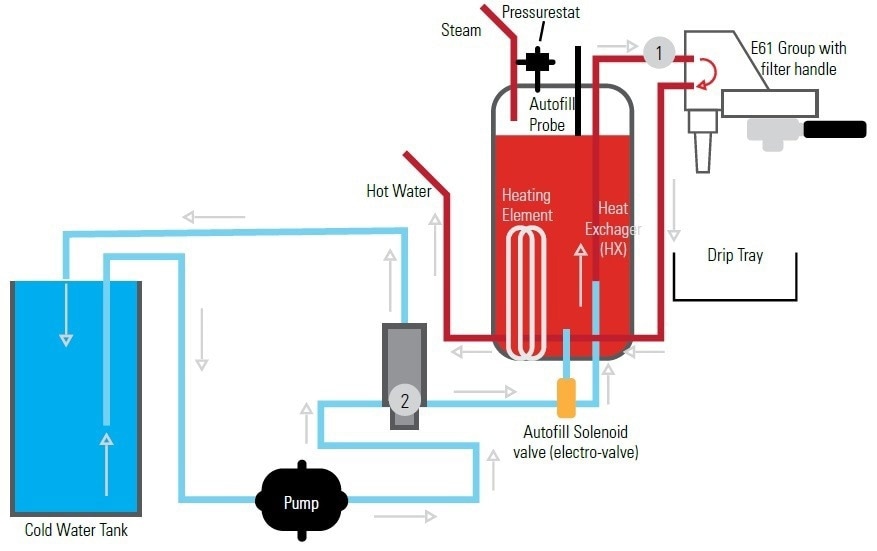In professional coffee machines, water pressure measurement is necessary for both the boiler and brewing loops.
Pressure instruments must be accurate, able to withstand the temperatures and stresses generated by cleaning processes, and have specialized wetted parts. For safe food production assurance, pressure instrumentation must be certified for drinking water and food application.
To ensure the quality of the espresso, the brewing pressure (pump outlet pressure) must remain stable.
To maintain pressure stability, espresso machine manufacturers install an overpressure valve (OPV) at the pump outlet side. Although an OPV can be adjusted with a screwdriver, it is not always easily accessible without dismantling the machine.
As manufacturers are constantly improving their technology and considering easy-to-use consumer requirements, modern coffee machines allow regulation of the brew pressure at the push of a button, which is easily accessible from outside the machine.
In this case, a proportional valve substitutes an OPV, and a pressure transducer is installed behind the valve.
Professional coffee and vending machines are available in both tabletop and freestanding models.

Image Credit: Sensata Technologies, Inc.
Working Principle
- Water can be pumped into the machine either by connecting it to the plumbing or by manually filling the tank
- Water is heated to a temperature of 95 °C in the boiler
- The temperature of the water is controlled by the pressure in the boiler
- A pressure switch in the boiler loop regulates this pressure
- In the brewing loop, a pressure transducer is utilized in conjunction with a proportional valve
- The heating elements of the steam, hot water, and brew boilers are controlled by an SSR
Solution
The brewing pressure, typically around 9 bar, can be monitored using a pressure transducer. This transducer can be installed in two different locations: either in the cold-water piping, where it is connected to the pump outlet, or in the hot-water piping, behind the boiler and closer to the end product.
The sensor is connected to the power source, and changes in the system pressure will cause a corresponding change in the output signal (voltage).
Recommended Products
Table 1. Source: Sensata Technologies, Inc.
| Reference on Diagram |
Product |
Features |
Function |
Brand |
| 1 |
 |
116CP/117CP
126CP/127CP* |
- Operating pressure range: 0-60 to 0-230 PSI (0-4 to 0-16 Bar)
- Supply voltage: 5 VDC ratiometric or 8-30VDC voltage regulated
- Output: 0-3.5 VDC, 0-4.5 VDC, or 4-20 mA
- Pressure port: Quick Connect, G1/4, G3/8
- Electrical connection: RAST 2.5
|
Monitoring of the pump outlet pressure / heated water supply pressure |
Sensata Technologies |
| 2 |
 |
60CP/70CP
81CP
100CP
35CP |
- Operating pressure range: 0-15 to 0-750 PSI (0-1 to 0-50 Bar)
- Supply voltage: 5 VDC ratiometric or 8-30 VDC voltage regulated
- Output: 0-4.5 VDC or 4-20 mA
- Pressure port: 1/8"" NPTF-2A male, 1/4"" NPTF-2A male, G1/8, G3/8
- Drinking water certified options available
|
Monitoring of the pump outlet pressure / heated water supply pressure |
Sensata Technologies |
*Drinking water certified
Diagram

Image Credit: Sensata Technologies, Inc.

This information has been sourced, reviewed and adapted from materials provided by Sensata Technologies, Inc.
For more information on this source, please visit Sensata Technologies, Inc.